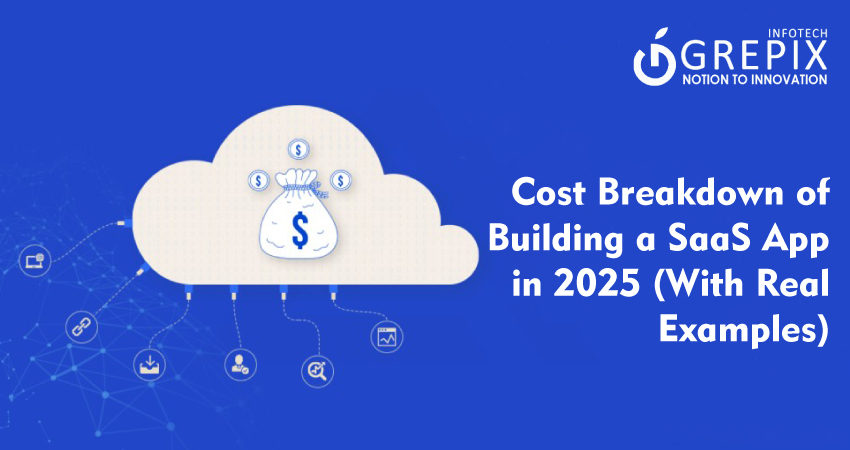Cost Breakdown of Building a SaaS App in 2025
Building a SaaS app in 2025? You're not alone. With businesses racing to digitize and automate workflows, the demand for SaaS (Software as a Service) apps has never been hotter. But before diving in headfirst, it's smart to ask: what will it actually cost?
Whether you're a founder sketching your next startup on a napkin or a product manager inside a growing company, knowing the financial side of software development is crucial. The truth? Costs vary wildly depending on scope, tech stack, and who you hire. But don’t worry we’re breaking it all down for you with real-world examples, simple language, and pro tips.
Let’s walk through the full cost breakdown of building a SaaS app in 2025 feature by feature, dollar by dollar.
Building a SaaS app in 2025 is both an exciting and strategic move. But knowing how much it will cost is key to planning, execution, and sustainability. Whether you’re a bootstrapped founder or a VC-backed entrepreneur, understanding the breakdown—from UI/UX design and full-stack development to DevOps and QA—is critical. Costs can range from $49,000 to $143,000 depending on scope, features, and team location. Real-world examples show that both lean teams and funded companies can succeed with the right strategy. Partnering with a trusted development company like Grepix Infotech helps reduce risk and time-to-market while ensuring product quality. So before you write your first line of code, make sure your budget aligns with your vision. Happy building!
What Is a SaaS App?
In simple terms, a SaaS app is cloud-based software that users access via a subscription. Think Slack, Notion, or Canva. No downloads, no headaches. Everything lives in the cloud and updates automatically.
SaaS models work well because they’re:
- Scalable
- Recurring-revenue-friendly
- Easy to deploy and maintain
Now let’s get to the meat of it: how much does it cost to build one from scratch?
Key Factors That Influence SaaS App Development Costs
Not all SaaS projects are created equal. Here's what impacts the overall cost:
1. Complexity of Features
Basic tools with user logins and dashboards are cheaper. But once you add complex features like real-time collaboration or AI integration, things escalate quickly.
2. Tech Stack and Tools
Some stacks require niche expertise. If you're going full serverless with AWS Lambda or using advanced AI APIs, expect to pay more.
Popular full-stack development tools in 2025 include:
- Frontend: React, Vue, Flutter Web
- Backend: Node.js, Django, Ruby on Rails
- Database: PostgreSQL, MongoDB, Firebase
- DevOps: Docker, Kubernetes, GitHub Actions
Working with a skilled full-stack developer means faster delivery, better performance, and fewer bugs.
3. Location and Team Structure
Are you hiring a U.S. agency? A European contractor? Or an offshore team from India or Ukraine? Geography greatly impacts hourly rates.
| Region | Hourly Rate (Avg) |
|---|---|
| US/Canada | $100–$200 |
| Western Europe | $80–$150 |
| Eastern Europe | $40–$70 |
| South Asia (India, etc.) | $25–$60 |
4. Team Composition
For a solid SaaS app, you typically need:
- Product Manager
- UI/UX Designer
- Frontend Developer
- Backend Developer
- QA Tester
- DevOps Engineer
You can either build this in-house (costly, slower) or hire a full-stack development team from a reliable partner like Grepix Infotech.
Typical Cost Breakdown of Building a SaaS App in 2025
Let’s take a hypothetical mid-tier SaaS app—say a project management tool like Trello Lite.
1. Discovery & Planning ($3,000–$10,000)
- Market research
- Feature roadmap
- Wireframes
- Tech architecture
This is your blueprint. Don’t skip it.
2. UI/UX Design ($5,000–$15,000)
- User flow diagrams
- Prototypes in Figma or Adobe XD
- Mobile responsiveness
Design isn’t just about beauty—it affects usability, churn, and conversion rates.
3. Frontend Development ($10,000–$30,000)
A frontend built with React or Vue that supports:
- Dashboards
- Forms and charts
- Notifications
- Mobile responsiveness
Bonus: Flutter Web is becoming increasingly popular for faster cross-platform delivery.
4. Backend Development ($15,000–$40,000)
Includes:
- User authentication
- Role-based access
- API development
- Business logic
- Notifications, billing, etc.
A solid backend = a smooth experience. And this is where full-stack development shines.
5. API Integration ($5,000–$20,000)
You’ll likely integrate:
- Stripe (Payments)
- SendGrid (Emails)
- Twilio (SMS/Voice)
- OpenAI or other ML APIs
Third-party services save dev time but require smart integration.
6. Admin Panel ($3,000–$10,000)
Track users, manage roles, and handle tickets without touching code. A must-have for scaling SaaS.
7. Testing & QA ($5,000–$10,000)
Includes:
- Manual testing
- Automated testing scripts
- Performance testing
Skipping QA is like skipping brakes on a car. Just don’t.
8. DevOps & Deployment ($3,000–$8,000)
- CI/CD pipelines
- Monitoring tools (Datadog, Sentry)
- Cloud hosting (AWS/GCP)
This ensures your app doesn’t go down at 3 a.m.
9. Ongoing Maintenance (15–25% of total cost annually)
Post-launch costs include:
- Bug fixes
- Feature enhancements
- Server upgrades
Total Cost Estimate
| Feature | Cost Range (USD) |
|---|---|
| Discovery & Planning | $3,000–$10,000 |
| UI/UX Design | $5,000–$15,000 |
| Frontend Development | $10,000–$30,000 |
| Backend Development | $15,000–$40,000 |
| API Integration | $5,000–$20,000 |
| Admin Panel | $3,000–$10,000 |
| QA & Testing | $5,000–$10,000 |
| DevOps & Deployment | $3,000–$8,000 |
| Total (One-time Build) | $49,000–$143,000 |
| Annual Maintenance (15–25%) | $7,350–$35,750 |
Real-World Example #1: Bootstrapped CRM App
A two-person team in India built a niche CRM for dental clinics. They hired a part-time UI/UX designer and one full-stack developer.
- Build time: 4 months
- Total cost: ~$28,000
- Revenue after 12 months: $100,000 ARR
Also Read: "How to Get a Full-Stack Product Team Without Hiring Internally"
Real-World Example #2: VC-Backed AI Scheduling Tool
A US-based startup built an AI-powered calendar app using a US agency.
- Build time: 7 months
- Total cost: ~$180,000
- Revenue after 18 months: $400,000 ARR
Tips to Reduce SaaS Development Costs in 2025
- Use No-Code/Low-Code Tools: Great for MVPs. Try Bubble, Outsystems, or FlutterFlow.
- Outsource Smartly: Hire a reliable full-stack development team offshore.
- MVP First: Build a minimal version, test the market, then scale.
- Open Source Is Your Friend: Use libraries to save time and money.
- Automate QA Early: Catch bugs before users do.
Full-Stack Developer vs. Specialized Teams
Many founders wonder: should I hire a full-stack developer or separate frontend/backend engineers?
Here’s the short answer: for startups or MVPs, a solid full-stack developer can do wonders. They’re cost-effective, move fast, and understand the full picture. For scaling SaaS apps, however, it’s better to bring in specialized roles.
Working with a full-stack development team like Grepix means getting that balance fast delivery with depth where it matters.
Hidden Costs You Shouldn't Ignore
- Legal & Compliance: Think GDPR, CCPA, HIPAA
- Customer Support Tools: Zendesk, Intercom, etc.
- Marketing Website: You’ll need one.
- Third-Party API Costs: They add up fast
Budgeting for these early on helps avoid unpleasant surprises later.
Should You Build In-House or Partner Up?
Let’s face it: hiring and managing your own dev team is expensive, time consuming, and risky especially if you’re non-technical.
That’s why startups often choose to partner with seasoned app development companies. With Grepix Infotech, you don’t just get codeyou get strategy, speed, and support.
Conclusion
At Grepix Infotech, we understand that building a SaaS app is more than just writing code it’s about solving problems, scaling businesses, and turning big ideas into functional, profitable products. As a leading mobile and web app development company, we’ve helped hundreds of startups and enterprises bring their SaaS visions to life across industries like healthcare, logistics, education, and fintech.
Our team of experienced full-stack developers, product strategists, UI/UX designers, and QA experts work together to ensure your product is not just functional, but scalable, user-friendly, and future-ready. Whether you’re looking to build a feature-rich SaaS app from scratch or improve your existing platform, we provide end-to-end support tailored to your unique needs.
We believe in transparency, quality, and speed and most importantly, we believe in partnerships. When you work with Grepix, you’re not just hiring a team. You’re gaining a long-term ally who’s invested in your success.
Let’s build something remarkable, together.
Get in touch with us today to discuss your SaaS project.
FAQs
1. How long does it take to build a SaaS app?
Typically 3–8 months depending on feature complexity and team size.
2. Can I build a SaaS app with one full-stack developer?
Yes, for MVPs and small apps. For larger apps, consider a full team or agency.
3. What’s the cheapest way to launch a SaaS?
Start with a no-code MVP or hire offshore developers with experience in full-stack development.
4. How much does ongoing maintenance cost?
Usually 15–25% of the initial development cost annually.
5. What if I need to scale after launch?
Plan your architecture for scale early on. Work with partners like Grepix who build with scalability in mind.
Launch your vision with our mobile app development company, where innovation meets excellence to create cutting edge mobile solutions."







